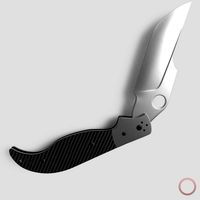GrabCAD

Fast seal
by GrabCAD
Last crawled date: 1 year, 10 months ago
Here is my seal proposal for sealing and locking mechanism. I propose a locking mechanism with a sliding lock fixed by a wedge. It is wery fast you only need to put two sliding bars in the brick, put the brick in th cavity and pump out the air from the cavity to squezze the seal. After this you fix the lock by inserting the wedge in the cavity.
Main problems:
• Long rectangular cavity form – difficult to seal, possible deformation
• Plastic material – relatively high deformation compared to metal.
• Changing loads directions.
Solutions.
• Locking mechanism with even load distribution along the cavity
• Choice of plastic material with high elasticity modulus
• Choice of seal to work with changing load directions
For locking mechanism I choosed a sliding lock between brick and cavity, wixed by a wedge.
For seal I took a Parker four-corner spliced gasket made from Nitril(N7021, Durometer 60) with hollow-o profile B015 and friction fit installation.
Pressure difference of 3 bar is applied to the cavity surface of 17564mm2.
Total force acting on the brick: 17564x10-6x3x105=5269N
The seal preload of 20 pound/inch applied on the 42.3 inches of the seal length give us additional 1226N. Total load on the brick - cavity connection will be 6495N.
When cavity is under vacuum a force of 1756N will be applied on the connection. Because the required seal preload force is of 1226N, pumping air from cavity will be enough to squeze te seal.
The seal diameter is of 3.52mm with maximum compression of 28%, that give us 0.99mm, and the minimum compression will be 20% to allow for 0.3 mm seal displacement because of tolerances set and cavity + block deformations once under loads.
The choice for cavity material was dictated by maximum rigidity to get minimum cavity deformation once under load. My choice is :
DuPont Performance Polymers Rynite® 540SUV BK544 Polyethylene Terephthalate (PET)
40% glass filled with Tensile Modulus 13.5 GPa, Tensile Strength 162 MPa. I got no data for this material yield strength but no reinforced DuPont PET Polymers have tensile strength up to 90 MPa.
FEA calculations(see screenshots) show that with maximum applied load the cavity deformation in in Z direction will be 35 microns(i consider only distance between seal gland bottom and point of contact between brick and cavity).We have 2.5 safety factor for equivalent stress.
Rough estimate of FEA results was made for tensile strength and directional deformation(in my estimate i didn't took into acount flexural stress).
For Tensile strength:
I took a cavity cross section 10mm wide. It give 130 N of total load in point of contact for cross section. We have 2 point of contact per crossection. Therefore for 1 point of contact: 130N/2 = 65N
Crossection minimum width is of 1.76mm. And crossection area is of 1.76mm x 10mm = 17.6x10-6 mm2.
Tensile stress in Z direction is therefore 3.7 MPa. It is of the same order for equivalent stress regions where no flexural stress is present(See picture Equivalent stress and Normal stress).
z Axis deformation rough estimate with no taking into acount flexural deformation was 3microns between point of contact and seal gland.This is close to FEA deformation regions with litle flexural stress.
Main problems:
• Long rectangular cavity form – difficult to seal, possible deformation
• Plastic material – relatively high deformation compared to metal.
• Changing loads directions.
Solutions.
• Locking mechanism with even load distribution along the cavity
• Choice of plastic material with high elasticity modulus
• Choice of seal to work with changing load directions
For locking mechanism I choosed a sliding lock between brick and cavity, wixed by a wedge.
For seal I took a Parker four-corner spliced gasket made from Nitril(N7021, Durometer 60) with hollow-o profile B015 and friction fit installation.
Pressure difference of 3 bar is applied to the cavity surface of 17564mm2.
Total force acting on the brick: 17564x10-6x3x105=5269N
The seal preload of 20 pound/inch applied on the 42.3 inches of the seal length give us additional 1226N. Total load on the brick - cavity connection will be 6495N.
When cavity is under vacuum a force of 1756N will be applied on the connection. Because the required seal preload force is of 1226N, pumping air from cavity will be enough to squeze te seal.
The seal diameter is of 3.52mm with maximum compression of 28%, that give us 0.99mm, and the minimum compression will be 20% to allow for 0.3 mm seal displacement because of tolerances set and cavity + block deformations once under loads.
The choice for cavity material was dictated by maximum rigidity to get minimum cavity deformation once under load. My choice is :
DuPont Performance Polymers Rynite® 540SUV BK544 Polyethylene Terephthalate (PET)
40% glass filled with Tensile Modulus 13.5 GPa, Tensile Strength 162 MPa. I got no data for this material yield strength but no reinforced DuPont PET Polymers have tensile strength up to 90 MPa.
FEA calculations(see screenshots) show that with maximum applied load the cavity deformation in in Z direction will be 35 microns(i consider only distance between seal gland bottom and point of contact between brick and cavity).We have 2.5 safety factor for equivalent stress.
Rough estimate of FEA results was made for tensile strength and directional deformation(in my estimate i didn't took into acount flexural stress).
For Tensile strength:
I took a cavity cross section 10mm wide. It give 130 N of total load in point of contact for cross section. We have 2 point of contact per crossection. Therefore for 1 point of contact: 130N/2 = 65N
Crossection minimum width is of 1.76mm. And crossection area is of 1.76mm x 10mm = 17.6x10-6 mm2.
Tensile stress in Z direction is therefore 3.7 MPa. It is of the same order for equivalent stress regions where no flexural stress is present(See picture Equivalent stress and Normal stress).
z Axis deformation rough estimate with no taking into acount flexural deformation was 3microns between point of contact and seal gland.This is close to FEA deformation regions with litle flexural stress.
Similar models
grabcad
free

~ GE Quick Connect ~
...cation do not exceed 0,5 mm. applied labyrinth construction seals ensure tightness of the scale of deformation.
greetings to all
grabcad
free

Airplane Bearing Bracket
... mpa (less than 1000 mpa)
am direction:
printing direction is perpendicular with maximum principal stress (look at the picture).
grabcad
free

SimScale Truck Underrun Protection Challenge
...imal v.m. stress <355 mpa
maximal deformation - - mm
p3 load case
maximal vm stress < 355 mpa
maximal deformation - - mm
grabcad
free

Optimized Truck Underrun Protection Device
...se (1.25 mpa applied pressure):
maximum von mises stress: 102.2 mpa
maximum deformation: 0.6701 mm
minimum factor of safety: 3.47
grabcad
free

Knuckle Joint
...ile stress (pin) :: 720 mpa
shearing stress (pin) :: 395 mpa
crushing stress (pin) :: 720 mpa
with factor of safety 6
grabcad
free

GE Quick Connect W
...and steel frame-brick, operation pressure can reach very high level without even any possibility to penetrate watertight sealing.
grabcad
free

GE Quick Connect
...of nbr. cavity does not deform over minimum threshold distance to allow pressure leakage by the seals as shown in the simulation.
thingiverse
free

Head of a Very Serious Dude (High Definition STL) Amazing Detail by into3D
...reak 3.5%
flexural strength 115 mpa
flexural modulus 3350 mpa
hdt (heat deflection temperature) 140c (284f)
print time 16 hours
grabcad
free

Stationary Holder Analysis-Bearing Load vs Normal Force
...retty much as have thought
force:-500n y component
bearing load: -500n y component
properties of mesh:
generate mesh
sizing: 2mm
grabcad
free

Knuckle Joint Analysis
...sing fusion 360, while ansys was employed for the subsequent analysis. the chosen material for this analysis is structural steel.
Seal
3d_ocean
$9

Folding Pocket Knife
...dagger ergonomic fight folding game high knife melee military seal sharp sharpener special spyder spyderco stab sword tactical war...
3d_ocean
$15

Shower
...furniture glass interior metal mixer pipe siphon table water seal blender 2.75a cycles render subdivided...
3ddd
$1

Nilleq Occasional Table (Wood)
...314 полигонов. f162 nilleq occasional table (wood); burnt log, seald into the acrylic glass. brand: bleu nature 30-30-45cmhttp://www.homeconcept.ru/catalog/section.php?section_id=13414 there...
3ddd
$1

Seal sofa by Kofod Larsen
...seal sofa by kofod larsen
3ddd
kofod larsen
measurements: 740.0 x 1500.0 x 820.0 mm (h x w x d)
3ddd
free

F163 KISIMI Occasional Table Acrylic Drifted Branches
...же сами понимаете... f163 kisimi occasional table, driftwood branches, seald into the acrylic glass 30-30-45cmhttp://www.homeconcept.ru/catalog/section.php?section_id=13415&sphrase;_id=167084 there is two models...
3d_ocean
$2

Red Wax Seal
...e scene for blender internal render, same result as preview) – 1x obj file (model only, without subd => 1153 poly) – 1x...
3d_ocean
$12

Cartoon Baby Seal Rigged
...el is fully rigged (pelvis,spine,head,mouth,arms,hands,legs,feet) and finely skined. the scene in 3d studio max file is exactl...
3d_ocean
$18

Caulking gun
...gun 3docean apply caulking cault gun mastic mastic gun sealnt squeeze caulking, gun, cault, mastic, mastic gun, squeeze, apply,...
3d_ocean
$6

Milk Bottles
...of milk bottles. pack contains 2 models of bottles, seald and opened...
3d_ocean
$5

Facebook LIKE seal stamp tool.
... in 3d studio max 2010, rendered in cinema 4d r13. 3d studio max 2010 project file included. multiformat obj file included. ci...
Fast
3d_export
$15

McDonalds 3D Model
...3dexport 2010 2011 2012 2013 2014 mcdonald's fast food fastfood hamburger burger coca cola lowpoly low-poly low poly max...
3d_export
$119

Holden Commodore 2011 sedan 3D Model
...holden commodore sedan pontiac gt australian sport saloon tuning fast 2010 2011 2012 2013 holden commodore 2011 sedan 3d...
3d_export
$50

Fast Food Restaraunt Set 3D Model
... tables chair seats pan tray bottles support boxes interiors furniture
fast food restaraunt set 3d model humster3d 33025 3dexport
3d_export
$50

Pontiac Firebird 3D Model
...smokey and the movie car muscle american usa sport fast coupe targa special pontiac firebird 3d model nonens 46600...
3d_export
$95

Falcon3D MD 80 Fast Cargo 3D Model
...t cargo corporate mcdonnell douglas us plane planes jet jetliner md-80
falcon3d md 80 fast cargo 3d model falcon3d 72916 3dexport
3d_export
$99

Vector W8 1990 to 1992 3D Model
...model 3dexport car v8 usa sport expensive rare coupe fast supercar super dreamcar vector w8 wector vector w8 1990...
3d_export
$99

Aston Martin Vanquish Volante 2014 3D Model
...2014 car convertible cabrio roadster sport british uk england fast spyder spider aston martin vanquish james bond rapide gb...
3d_export
$75

Audi R9 Prototype Car 3D Model
...3d model 3dexport audi r9 prototype car concept vehicle fast sport luxury r8 drive auto mobile automobileautomotive speed wheel...
3d_export
$99

Subaru Impreza STi 22b 1993 to 2000 3D Model
...model 3dexport japan car sport coupe subaru impreza turbo fast racing jdm 1993 1994 1995 1996 1997 1998 1999...
3d_export
$39

Dodge Challenger 3D Model
...dodge challenger 3d model 3dexport dodge challenger car muscle fast dodge challenger 3d model godzik 18503...
